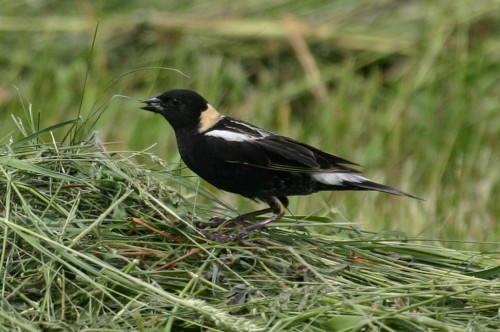|
RESEARCH |
||
In the last 30-40 years, Bobolinks and many other grasslands birds have suffered rapid decline. According to the BBS (Breeding Bird Survey), 25 out of 28 grassland bird species are suffering declines that are more widespread, consistent, and sharper than those seen in any other behavioural or ecological group. These declines are largely due to habitat loss and degradation of remaining natural habitat and agricultural intensification and alteration that has rendered much farmland habitat unusable or unsuitable. The biggest challenge facing Bobolinks breeding in Northeastern farmlands is early and more frequent mowing of hayfields. Today, the median hay cutting dates occur 2-3 weeks earlier than those of 50 years ago. This means that hay cutting now overlaps with the birds’ nesting season with disastrous results. It is estimated that a crippling 96% of eggs and nestlings are destroyed during early hay-cropping. Wildlife-friendly farming methods have an amazing potential to create habitat for the Bobolink and multiple other declining grassland species. Depending on how little or how much compromise can be reached between the balance of economics and conservation, several steps can be taken to render hay-fields and pastures ‘bird-friendly’. 1. If you can mow later, PLEASE DO Why: By delaying mowing to early July (or later), you will allow at least one successful breeding attempt. Costs: This delay may cause a lower CP% (crude protein) yield. A recent study (Nocera et al. 2005) concludes that this loss affects dairy or lactating cows predominantly. The later cut hay may be well suited for beef cattle, horses, and goats. Compromise: Even if you cannot mow all your fields later, consider delaying some. Do you have fields that are very wet, hard to get to, of lower quality to begin with? Can these be cut later than the others and act as ‘supplementary’ forage?
2. Keep a ‘bird-friendly’ rotation schedule Why: By allowing at least 25 days of idling on pastures in rotation you will allow birds enough time to breed. Costs: As with later mowing, there may be a marginal loss of CP%. Compromise: If you have enough land, follow the bird-friendly rotation during the peak nesting season only: mid-May to mid-July. After this time is usually when grass growth is slower and more land is needed to support livestock – but many grassland birds have already bred at least once.
3. Practice ‘Bobo-friendly’ mowing Why: A couple of small steps can make a difference. a. Mow inside-out or in strips from side to side – this allows young birds that are poor flyers a chance to escape the machinery. b. Raise the sickle bar or rotary blade height as much as possible, to reduce nest destruction and leave residual cover. c. Take it slow – if you see young birds on the ground, give them a chance to escape. Costs: Minimal - only slightly more time required in some cases.
4. Go native Why: Planting some fields with native warm-season grasses that mature later and are more drought resistant can both increase or prolong your hay harvest and provide habitat for grassland birds as it is mown late (after July 15th). Costs: Because they compete poorly with the more common exotic cool-season grasses and weeds, it can take a bit of time and patience to get warm-season grasses growing. See the following resources for more details:
For the Bobolink and many other bird and animal species, their continued presence in our landscapes depends on our actions and our considerations of priorities. For their survival it is essential for conservation to occur on private land by a conscientious society. Help stop the advent of a second ‘silent spring’ – protect our grassland bird species. For more information please contact: Barbara Frei M.Sc. Candidate Natural Resource Sciences
21,111 Lakeshore Macdonald Campus McGill University Ste-Anne-de-Bellevue, QC
H9X 3V9
|




